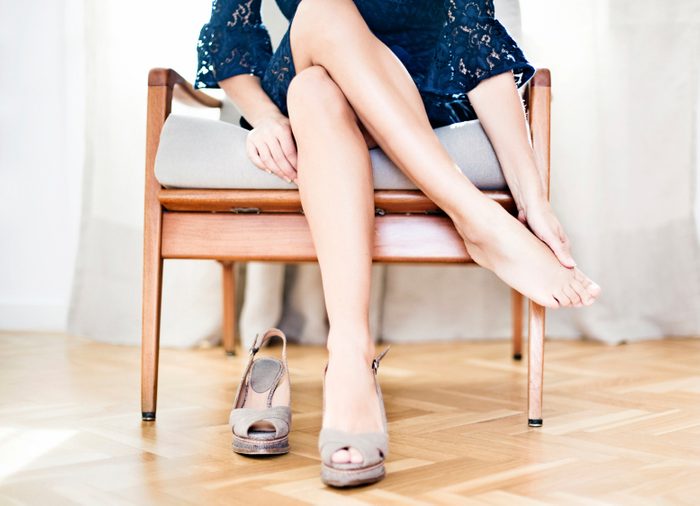
Pamper your feet
Our poor feet. No other body part takes as much abuse. We’re either squeezing them into shoes that are too tight, standing for hours in heels or pounding the pavement in a daily attempt to get fit. Well, the time has come to show our tootsies a little TLC.
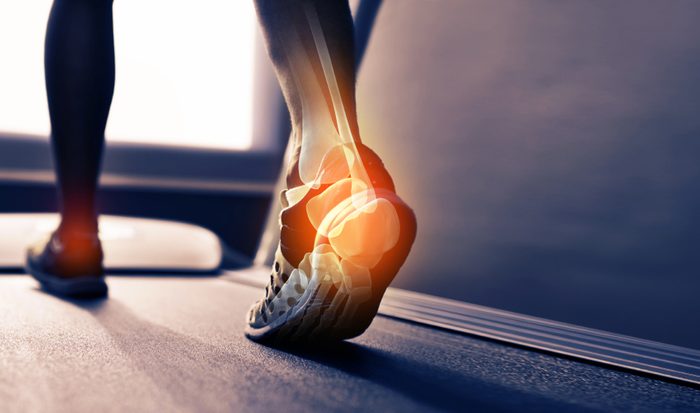
Athlete’s Foot
A contagious infection caused by a fungus, athlete’s foot can result in sore, red, itchy or flaking skin or itchy, white or peeling skin between the toes.
Trigger: Your foot probably came in contact with a surface that was touched by someone with the infection, such as a pool deck, shower stall floor, or even borrowed shoes. Because the fungus thrives in warmth, darkness and moisture, anything that keeps your feet in those conditions increases the chance of the fungus getting a toehold. “It doesn’tcause the fungal infection, but a moist environment between the toes can cause maceration and skin breakdown, which opens up a portal for it,” explains John-Paul Gordon, a podiatrist with The Podiatry Associates in St. John’s, NL. Similarly, damage (dry, cracked, peeling nails) from wearing polish or gel nails for extended periods can make toenails vulnerable to fungal nail infections.
Fix: For prevention, consider wearing water shoes or flip-flops around the pool, says Stephen Hartman, a chiropodist and CEO of the Canadian Federation of Podiatric Medicine and proprietor of Foot Works, a chiropody clinic in Waterloo, ON. But if you already have an infection, the best wayto fight it is with creams and lotions (for skin or nails) and liquid solutions (for between the toes) containing antifungal medications. Look for ingredients like clotrimazole, miconazole, terbinafine and undecylenic acid.
It’s also important to follow directions carefully and use the product for the recommended time – between two and four weeks, says Phil Hudson, a pharmacist in Waterloo, ON. (You may need to use a treatment for toenail fungus for several weeks to a whole year.) Try Emtrix, $35. Many people make the mistake of quitting as soon as the itching stops, only to have the infection flare up again. “Fungi are very good at lying low,” says Hudson. “They have the ability to go into a dormant, low energy phase when conditions become too arduous or hostile. They fire up again when the conditions improve.” If your symptoms return or you notice clues of a fungal nail infection – like thickening or discolouration – see your doctor, podiatrist or chiropodist promptly. But that’s only half the battle: You also have to treat your footwear. Sprays and powders containing tolnaftate are one option. “You can also put your shoes in a plastic bag, seal it and put it in the freezer for 24 to 48 hours,” adds Gordon.
For pedicured toes, Gordon recommends removing varnish every three to four weeks, laying off the varnish for a few days and moisturizing the nails. Try CND Solar Oil, $14.
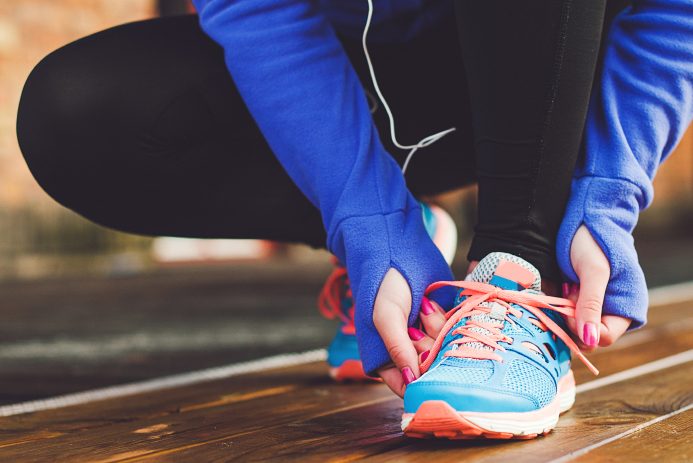
Blisters
These tender wounds are pockets of fluid (usually a watery substance called serum) that collect under the skin.
Trigger: Blisters are usually a result of friction. Illfitting footwear, like a slightly too-large shoe that allows the foot to slide around inside, or poorly fitting socks are two likely culprits.
Fix: If the blister is intact, don’t pop it. Instead, cover it with an adhesive foam or adhesive orthopedic felt doughnut pad to ease pressure on the area or cover it with antibiotic ointment and gauze. If the blister breaks, apply antibacterial cream and a bandage to prevent infection.
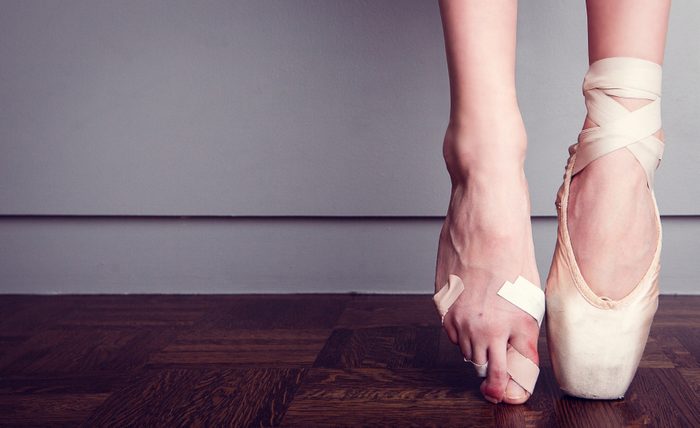
Calluses & Corns
These are areas of dead, thickened skin: Calluses are more superficial and may be either painless or painful, while corns are smaller, concentrated lumps that can put pressure on a nerve and cause sharp pain. Corns on the top or bottom of the foot tend to be cone-shaped, and sometimes corns on the sole look much like plantar warts. The telltale difference? Fingerprint-like lines in the skin continue unbroken through a corn, though it’s difficult to notice this with the naked eye.
Trigger: Calluses and corns are the body’s response to pressure, with calluses being precursors to corns. Both may be the result of concentrated stress on one spot or your bone structure, such as having flat feet. Corns on the top of the foot are often caused by shoes that aren’t roomy enough; those on the bottom are more likely caused by how your foot is shaped, the way you walk, your choice of footwear or your job, if you do a lot ofstanding or walking.
Fix: You can gradually reduce the thickness of calluses by rubbing them with a pumice stone, but be careful not to take off too much. “Calluses are the body’s way of protecting sensitive skin, so don’t be overaggressive,” says Hartman.
You can also file while bathing once or twice a week. Most over-thecounter corn remedies contain salicylic acid, which softens the dead skin so it can be sloughed off. Look for products that contain the medication on the corn, so that the surrounding healthy skin doesn’t get burned. (People with diabetes should avoid these products.) Alternatively, a podiatrist or chiropodist can simply cut out the core, alleviating the pain immediately. To ease pain temporarily, you can try a product like Dr. Scholl’s Round Callus Cushions, $3.50.
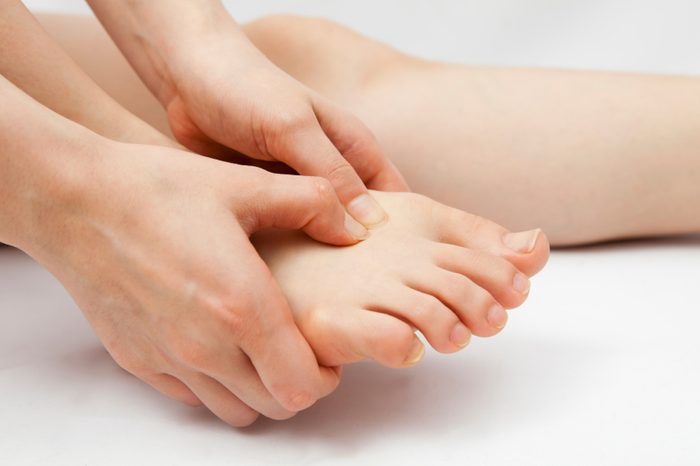
Dry Heels
You know you have this condition if your feet are cracked and feel hard to the touch.
Trigger: While this can sometimes signal athlete’s soot if the entire bottom of the foot is dry, often it’s simply caused by the body’s inability to lubricate the skin enough, such as having a lack of natural oils, the inability to sweat properly or the way we walk.
Fix: A thick cream containing urea or lanolin can soften the skin and seal in moisture. “The key is consistency,” says Gordon, adding that you’ll see the best results if you apply moisturizer daily. If the skin is broken and infected, though, cover the spot with antibiotic cream and a bandage and see your doctor, podiatrist or chiropodist.
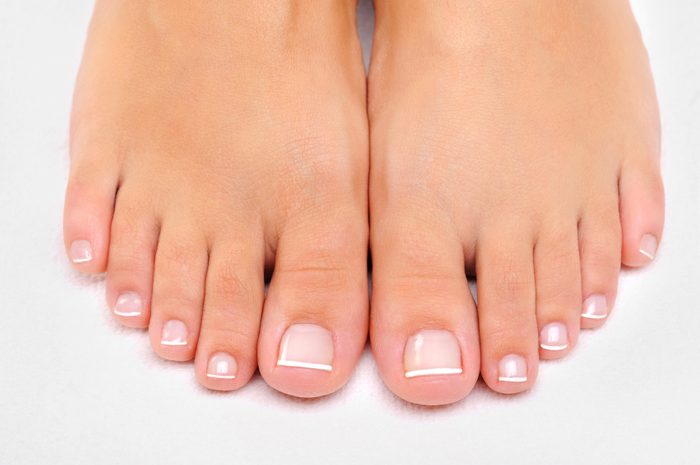
Ingrown Toe Nails
Toenails with a sharp, top edge or curved side edges begin to grow into the adjacent skin and cause pain.
Trigger: Cutting your nails too short can lead to ingrown nails, as can too-snug shoes or socks. When the side edges of the nail are ingrown, it’s a chronic, hereditary condition produced by the curvature of the nail.
Fix: Sometimes pain at the edge of the toenail is actually due to a buildup of dead skin, says Gordon. Gently rubbing it away with a cotton swab after soaking the foot can bring relief. Caught early enough, an ingrown nail may only need a soak in Epsom salts and time to grow out, adds Hartman. He recommends that nails be cut straight across, not too short. Try not to cut down the side because it can perpetuate the problem or make it worse.
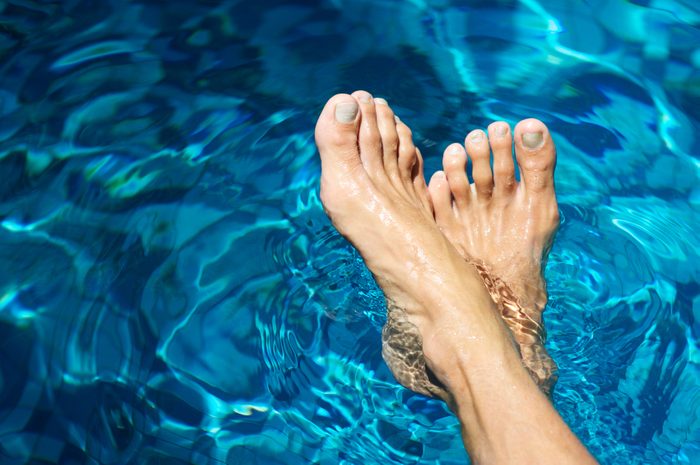
Plantar Warts
These lesions occur when a virus infiltrates the skin on the sole of the foot, causing skin cells to rapidly regenerate and pile up, forming a hard lump that resembles a corn. The difference between corns and plantar warts is that warts are most painful when squeezed on the sides, while corns are most painful when direct pressure is applied.
Trigger: You catch warts the same way you would athlete’s foot: The fungus thrives in warmth, darkness and moisture.
Fix: Eventually, your body will kill the virus. Although it’s generally not necessary to treat warts unless they’re spreading or causing pain, you should see a doctor, podiatrist or chiropodist immediately as a preventive measure and for aesthetic reasons. (In the meantime, if you share a bathroom, wear flip-flops in the shower to avoid passing the infection on.) Using salicylic acid to slowly eat away the dead skin or a freezing solution to freeze and kill the virus (avoid both if you have diabetes) can sometimes help “wake up” immune cells and clear the infection – a process that can take a few weeks to years because warts are very resistant, and everyone and every wart is different.
